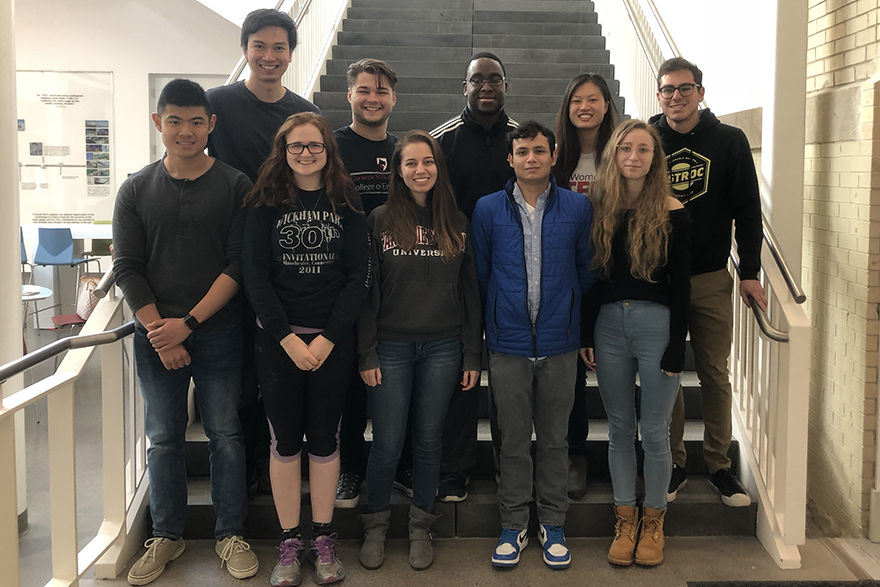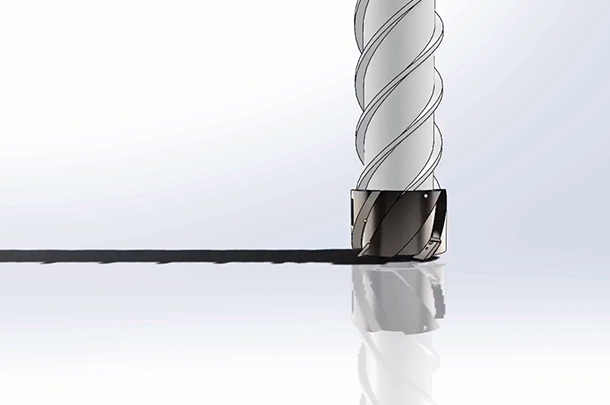CMU team in NASA Mars ice drilling competition
A team of engineering undergraduate students is one of 10 finalists competing to develop a robot that can drill ice on Mars for a prestigious NASA challenge.
Space exploration is no simple task. As astronauts look to neighboring planets for expeditions, they need to consider all the resources available to them, such as the large subterranean ice deposits under Mars’ crust. This untapped water could serve as fuel for a lengthy return trip to Earth, but first, we need a way to harvest it.
Such is the challenge issued by NASA this year. A team of undergraduate engineering students from Carnegie Mellon will design and construct a prototype robot that can extract ice from a simulated Martian landscape. They are one of 10 finalist teams.
The Tartan Ice Drilling System (TIDS) team is comprised of 15 students spanning various majors in the College of Engineering. The team is advised by Mechanical Engineering (MechE) Professor Aaron Johnson who shares his expertise in robomechanics with them. Ph.D. candidate Catherine Pavlov also advises the team, drawing from her previous research experience at NASA.
I think [working with engineers from various majors] is one of my favorite parts of this project.
Devin Gund, Senior, Electrical and Computer Engineering, Carnegie Mellon University
Five of the students serve as project leads in four subgroups that are essential to the success of the ice drilling robot. The goal is to drill for ice mostly autonomously. Although the robot is demoing on Earth, the team will also need to know how to tweak it should it actually get sent to Mars.
Paula Zubiri, a junior in MechE, oversees the structure of the robot and the XYZ position system. She ensures that the drilling mechanism does not overpower the body of the machine and cause it to unwind itself while drilling.
“A lot of my MechE background deals with analysis of, not just structures, but how different objects interact,” says Zubiri. “We’re going to be dealing with a drill rotating at really high velocity and really high torque in the middle our system.”

Source: CMU TIDS team
Members of the Tartan Ice Drilling System Team
Devin Gund and Christina Ou are a senior and junior in Electrical & Computing Engineering (ECE) respectively. They lead the controls subgroup which handles the software of the robot. Because autonomy is an important goal of the project, the robot will need to sense where the drill should penetrate the ground, how deep, and at what speed.
“We’re looking at all the environmental data from sensors and then controlling the rest of the machinery appropriately,” says Gund. “ECE is the perfect background for that because it’s just a mix of hardware and software.”
Tim Cote, a senior in Materials Science & Engineering (MSE), is in charge of the drill subgroup and the careful selection of metals for its construction. The team walks a fine line of needing to make everything as light as possible for space travel efficiency but as strong as possible to withstand extreme speeds, forces, and temperatures.
We will be working in the new hands-on maker space [The Tech Spark] that they created in Hamerschlag.
Caroline Morin, Senior, Chemical Engineering & Biomedical Engineering, Carnegie Mellon University
Cote explains that “in materials science, engineers need to maximize all the different properties that you want to get the best material for the job.... I can’t just throw a huge steel bar up on Mars because it’s too heavy.”
Caroline Morin, a senior studying Chemical Engineering and Biomedical Engineering, oversees the subgroup for water extraction and purification. They need to account for temperature and pressure to manipulate ice, water, or vapor at certain points in their process. They want to thermally distill the ice without having it sublimate—rapidly change from solid to gas.

Source: CMU TIDS team
Early CAD file of the drill which will puncture ground and extract ice
“You don’t just have somebody up there who can change…membranes,” Morin explains, reemphasizing the robot’s need for autonomy since astronauts will not be available to change out replaceable parts, such as membranes or filters. “We will vaporize the water and then recondense it so that we are able to fully separate it from all minerals.”
The TIDS team is bolstered by support from Carnegie Mellon faculty and staff in the form of mentorship, funding management, and access to cutting edge work spaces.
“CMU has been really helpful with the whole process…. Because we are a student project, we will be working in the new hands-on maker space that they created in Hamerschlag,” Morin remarked, referring to The Tech Spark, the maker space on the C-level of Hamerschlag Hall that has served as the TIDS team’s base of operations.
The team came together from separate programs and classes due to a common love for space technology. “The amount of challenges that need to be overcome to achieve these amazing things, it just blows me away every time,” Cote said, reflecting on what first got him interested in the project. Zubiri added that, “the idea is that you don't waste anything. It's sustainable on a spaceship. That’s like my MechE mind thinking how to make everything efficient.”
“I think [working with engineers from various majors] is one of my favorite parts of this project,” Gund added. “It's really just cool and impressive to be working with people outside of my field of study that know things that I don't. I really enjoy that.” In addition to the subgroup leads, these people include engineering students Jordan Aaron, Simone Hugh Sam, Thor Mercier, Emily Newman, Cesar Quinones, Andres Ramirez, Nikki Scavone, Joe Taylor, Kam Undieh, and Boyao Yu.
The members of the Tartan Ice Drilling System team will compete at the final demo day for NASA’s RASC-AL Challenge June 5 - 7. Learn more or support the team in their efforts by visiting their website: cmumarsice.com.
